

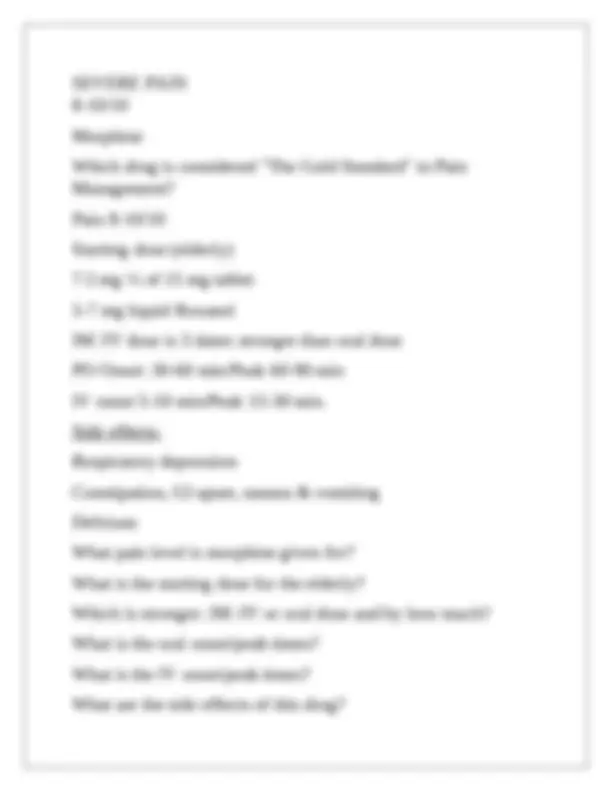
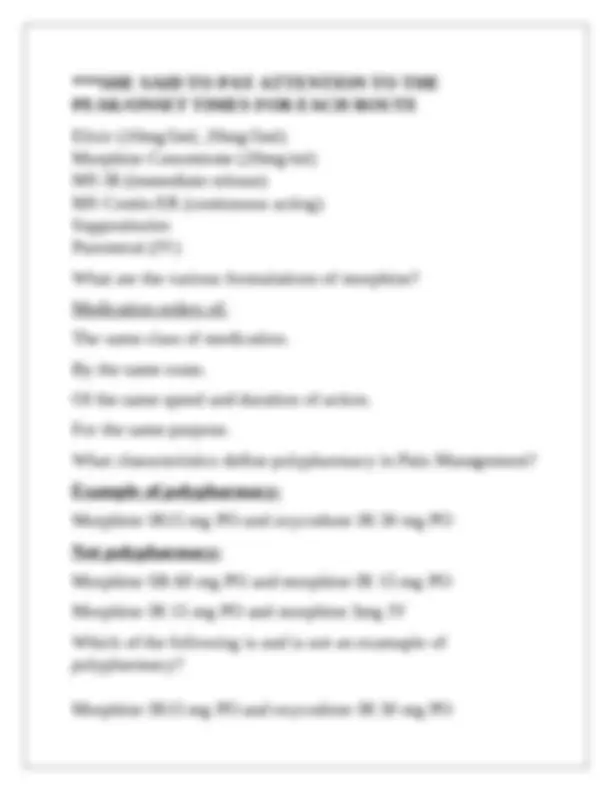

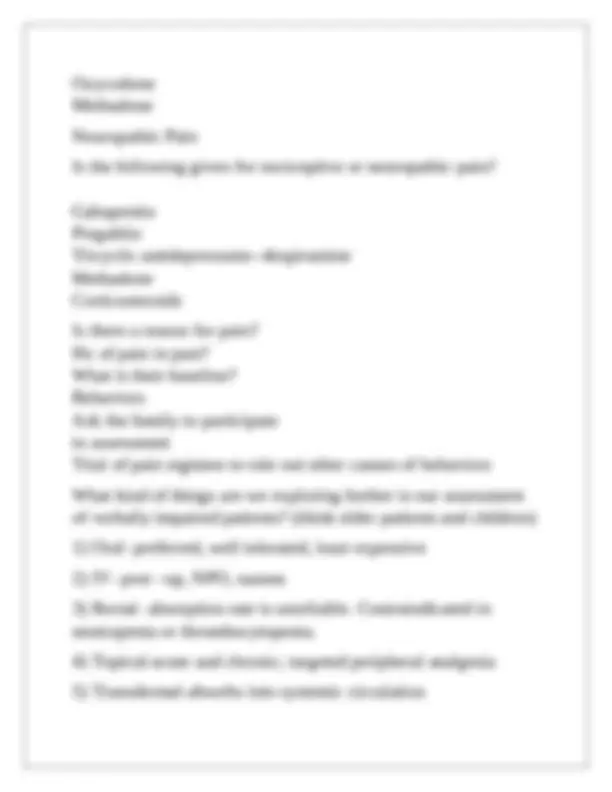
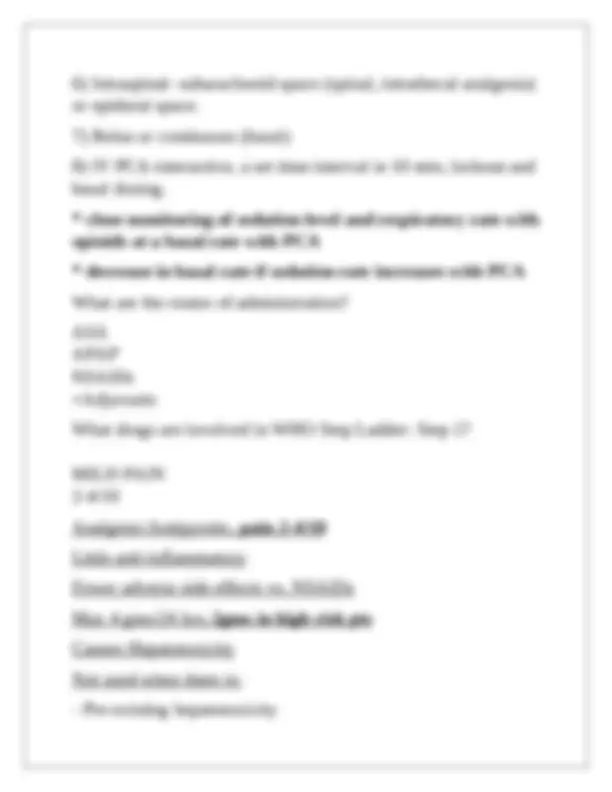
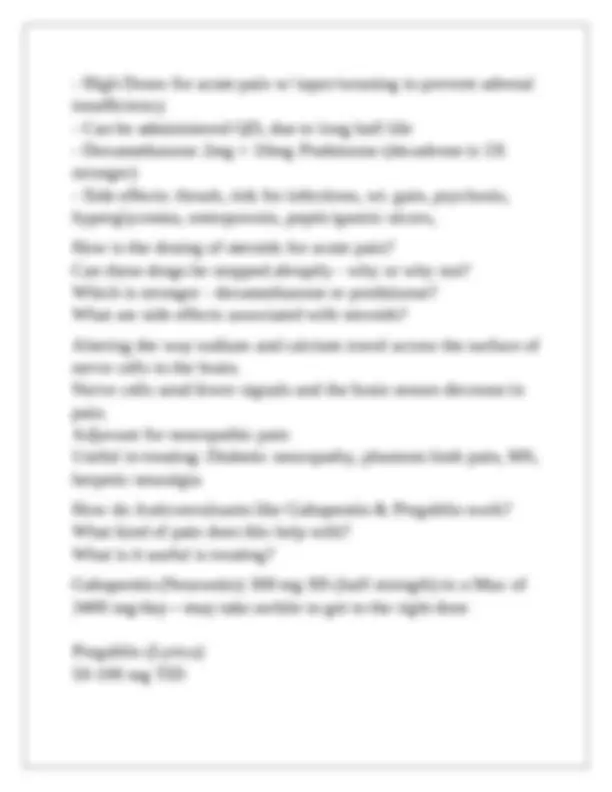
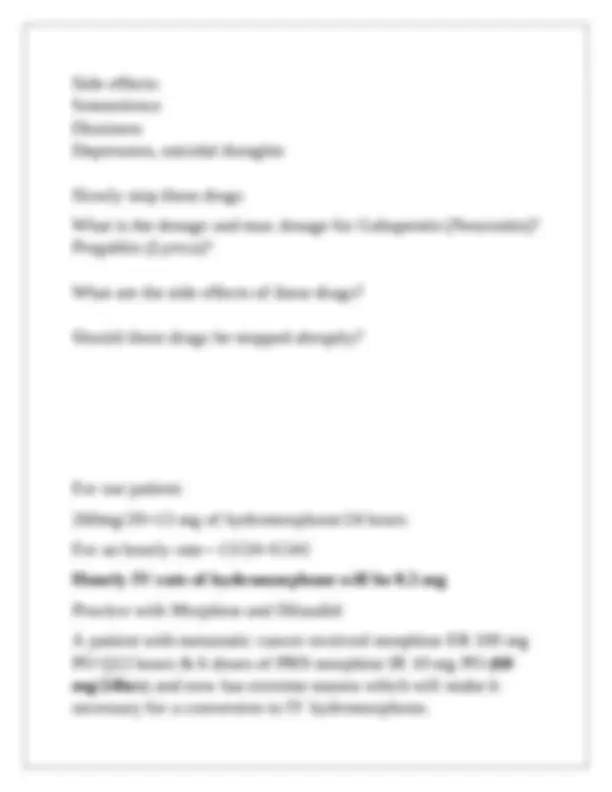
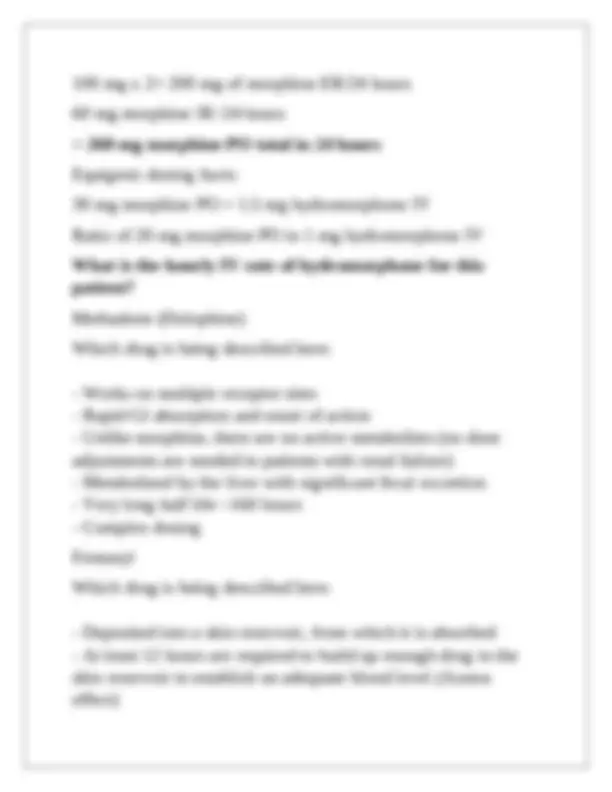
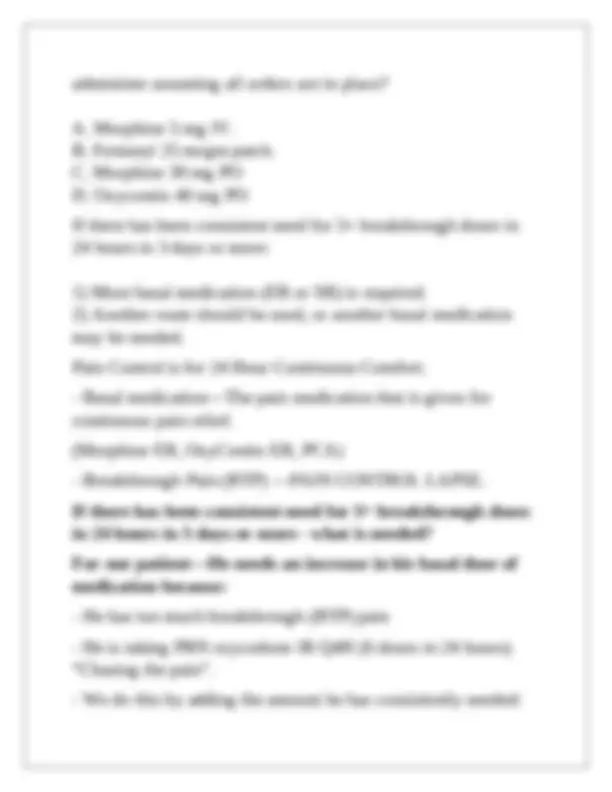



Study with the several resources on Docsity

Earn points by helping other students or get them with a premium plan


Prepare for your exams
Study with the several resources on Docsity

Earn points to download
Earn points by helping other students or get them with a premium plan
Community
Ask the community for help and clear up your study doubts
Discover the best universities in your country according to Docsity users
Free resources
Download our free guides on studying techniques, anxiety management strategies, and thesis advice from Docsity tutors
NU 455 - EXAM 3 - Week 7: Pain Management Questions With Complete Solutions
Typology: Exams
1 / 19

This page cannot be seen from the preview
Don't miss anything!












NU 455 - EXAM 3 - Week 7: Pain Management Questions With Complete Solutions (A/Codeine) = Tylenol /Codeine # (A/Hydrocodone) = Vicodin (A/Oxycodone) = Percocet (Tramadol) = Ultram What drugs are involved in WHO Step Ladder: Step 2? MODERATE PAIN 5-7/ Pain 5-7/ Codeine 60 mg / APAP 300 mg Synergistic action = potentiation of drugs 1-2 tabs q4 hours Side Effects: Drowsiness, constipation, n/v, urinary retention, respiratory depression What pain level is (A/Codeine) = Tylenol /Codeine #3 used for? What is the dose ratio of codeine to APAP? How often can patients have 1-2 tabs? What are the side effects of this drug? Pain 5-7/ Tramadol 20-50 mg qd
Extended release form = Ultram ER 100 mg qd Combination form = Ultracet Tramadol 37.5 mg /APAP 325 mg Potentiates action of SSRIs and Coumadin (mania and bleeding concerns) Not to be used with: opioids seizures disorders Renal or hepatic impairment Side effects Drowsiness, n/v, constipation, CNS stimulation, seizures, What pain level is Tramadol (Ultram) used for? What is the daily dose? What is the extended release dose? What is the dosage for the combination form Ultracet? (how much tramadol vs APAP) What drugs are potentiated by this drug? When should this drug not be used? What are the side effects? They are all true facts:. It occurs in opioid naïve patients. It occurs when too large a dose is given. It can occur when renal/hepatic issues or in elderly. Hypotension can occur esp. in volume depleted patients.
Morphine Which drug is considered "The Gold Standard" in Pain Management? Pain 8-10/ Starting dose (elderly) 7.5 mg ½ of 15 mg tablet 5-7 mg liquid Roxanol IM /IV dose is 3 times stronger than oral dose PO Onset: 30-60 min/Peak 60-90 min IV onset 5-10 min/Peak 15-30 min. Side effects: Respiratory depression Constipation, GI upset, nausea & vomiting Delirium What pain level is morphine given for? What is the starting dose for the elderly? Which is stronger: IM /IV or oral dose and by how much? What is the oral onset/peak times? What is the IV onset/peak times? What are the side effects of this drug?
Elixir (10mg/5ml, 20mg/5ml) Morphine Concentrate (20mg/ml) MS IR (immediate release) MS Contin ER (continuous acting) Suppositories Parenteral (IV) What are the various formulations of morphine? Medication orders of: The same class of medication. By the same route. Of the same speed and duration of action. For the same purpose. What characteristics define polypharmacy in Pain Management? Example of polypharmacy: Morphine IR15 mg PO and oxycodone IR 30 mg PO Not polypharmacy: Morphine SR 60 mg PO and morphine IR 15 mg PO Morphine IR 15 mg PO and morphine 3mg IV Which of the following is and is not an examaple of polypharmacy? Morphine IR15 mg PO and oxycodone IR 30 mg PO
3) Visceral —Diffuse intestines, gastric, gall bladder What are the 3 types of nociceptive pain? **1) Phantom pain
D. Breakthrough pain What types of meds would you expect him to be on? A) Check the MAR for the last 48 hours to see what has been administered. You are a charge nurse. A patient with chronic pain reports to you that the nurses have not been responding to requests for pain medication. What is your initial reaction? A) Check the MAR for the last 48 hours to see what has been administered. B) Ask the nurse educator to provide in-service training about pain management. C) Perform a complete pain assessment and take a pain history. D) Have a conference with the nurses responsible for the care of this patient. Nociceptive Pain Is the following given for nociceptive or neuropathic pain? ASA, APAP NSAIDs APAP/Codeine # APAP/Hydrocodone APAP/Oxycodone Tramadol (Ultram) Morphine
Given with an NSAID (unless contraindicated) in scheduled doses post- op NOT PRN Acetaminophen What kind of drug is it? What pain level is it given for? Does it have anti-inflammatory properties? Are there more or less side effects than NSAIDS? What is the max dosage for Tylenol? What is a big adverse effect with this drug? When do we not use this drug? Can we give with NSAIDS? Nociceptive pain, pain 2-4/ Muscle, Joint Pain Very effective for cancer related bone pain Ceiling effect, cannot give over prescribed upper dose NOT FOR ANYONE 80> for PROLONGED USE Gastrointestinal Side Effects / bleeding Administer lowest effective dose Avoid anticoagulants /corticosteroids GI Protection: PPI NSAIDs What kind of pain does this drug treat? What pain level is it given for?
Side effects: Somnolence Dizziness Depression, suicidal thoughts Slowly stop these drugs What is the dosage and max dosage for Gabapentin (Neurontin)? Pregablin (Lyrica)? What are the side effects of these drugs? Should these drugs be stopped abruptly? For our patient: 260mg/20=13 mg of hydromorphone/24 hours For an hourly rate—13/24=0. Hourly IV rate of hydromorphone will be 0.5 mg Practice with Morphine and Dilaudid: A patient with metastatic cancer received morphine ER 100 mg PO Q12 hours & 6 doses of PRN morphine IR 10 mg PO ( mg/24hrs ) and now has extreme nausea which will make it necessary for a conversion to IV hydromorphone.
Route Transdermal (TD) (12-24 hours) Oral (PO) (30-45 mins) Sublingual (SL) (30 minutes) Subcutaneous (SC/ IV) (10 minutes) Intrathecal (IC) pump (minutes and continuous) Order the following by slowest to fastest Time to Peak Serum Concentration (C-Max): Route Oral (PO) Sublingual (SL) Transdermal (TD) Subcutaneous (SC/ IV) Intrathecal (IC) pump It is the exception! Anticipate the pain - do not chase the pain! Is PRN the exception or the norm? A. Morphine 5 mg IV. The RN is assessing a patient newly admitted with malignant breast cancer. She was taking her PRN morphine 15 mg PO regularly every 4 hours at home for pain. She is in excruciating pain now. Which of the following medication should the RN
Do the math: 6 doses of 5 mg oxycodone IR in 24 hrs: 5mg x 6 doses= 30 mg in 24 hours has been consistently needed in BTP doses. This 30 mg is now added to his basal medication dose Example: 78 y.o. male patient with prostate cancer has severe back pain 8/10 from metastatic disease to his spine. He takes OxyContin 20 mg PO q12 hours He needed oxycodone 5 mg PO PRN q 4 hours for the past 4 days. What should we do?